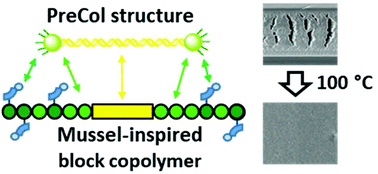A translation of the structure of mussel byssal threads into synthetic materials by the utilization of histidine-rich block copolymers†
Abstract
Mussel byssal threads are well-known due to their self-healing ability after the mechanical stress caused by waves. The proposed mechanism demonstrates the importance of reversible histidine–metal interactions as well as the block copolymer-like hierarchical architecture of the underlying protein structure. Taking these two aspects as inspiration for the design of synthetic analogs, different histidine-rich block copolymers were synthesized via reversible addition–fragmentation chain transfer (RAFT) polymerization. The hard domain was mimicked using polystyrene and the soft domain consists of n-butyl acrylate (BA) as well as histidine moieties as ligands. The block copolymers were crosslinked using different zinc(II) salts and the resulting metallopolymers were investigated with respect to their self-healing abilities. The observed two-step mechanism of the self-healing process was studied in detail. Furthermore, the mechanical properties were determined by nanoindentation and were correlated with other results.



 Please wait while we load your content...
Please wait while we load your content...